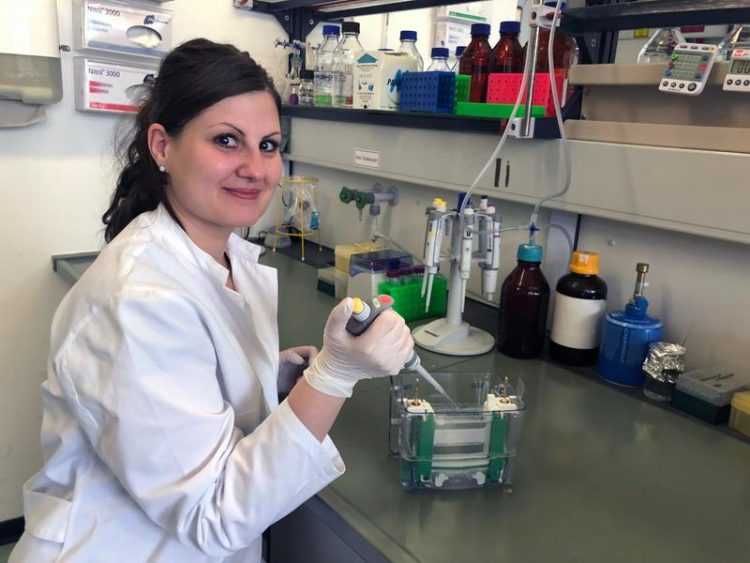The pharmacological “fingerprint“ of the fourth opioid receptor

Pharmacologist Dr. Anika Mann from Jena University Hospital studied the regulation of the fourth opioid receptor. Picture: Katja Bornkessel/UKJ
Also known as Orphanin FQ-receptor, the nociceptin receptor is the youngest member in the opioid receptor family. Receptors are large protein molecules located in the cell membrane of nerve cells that function as docking stations for external signal molecules and then transmit this information inside the cell.
In this way, they regulate important functions in the central nervous system, including pain perception, motivation or reward. All opioid receptors are targets for pain-alleviating drugs, that includes morphine binding to the most-studied µ-opioid receptor, as well as the closely related δ- and κ-opioid receptors and the nociceptin receptor that was first described 25 years ago.
Depending on the receptor type, drug effects are often followed by undesirable side-effects, ranging from respiratory depression, development of tolerance and dependence, to seizures, mood changes and dizziness.
The development and aggressive marketing of synthetic and highly-potent opioids targeting the µ-opioid receptor but which quickly lose their effectiveness after prolonged use, has led to the so-called “opioid epidemic” with an average 130 casualties per day in the USA alone. Scientists and pharmaceutical companies are therefore searching with urgency to find new and safer drugs for the treatment of severe pain. In their focus are now also the nearest relatives of the µ-opioid receptor.
Stefan Schulz, professor of pharmacology and toxicology at the University Jena Hospital, has worked for many years with his research team on the signaling properties of opioid receptors. One important step in this process is the attachment of phosphate groups to the receptor protein.
“This phosphorylation changes the shape and binding properties of the receptor and regulates therefore the receptor activity. Phosphorylation is most important for desensitization when the receptor is flooded by signaling molecules, eventually becomes insensitive and finally gets internalized into the cell”, explains Stefan Schulz.
In a research collaboration with scientists from the universities of Toulouse, St. Louis, Boca Raton, Montreal, Seattle and Mountain View and with support from the German Research Council within the Transregio “ReceptorLight”, Prof. Schulz’s research team now studied the activity of the nociceptin receptor and took its pharmacological “fingerprint”. The scientists studied the receptor phosphorylation after adding various natural and synthetic drugs. Their results were now published in the prestigious journal Science Signaling.
“By tagging with specific antibodies we could localize four different phosphorylation sites in cell culture and determine the temporal sequence in which they get phosphorylated. The various drugs differ in their efficiency how they can activate the receptor and trigger the phosphorylation”, summarizes first author Dr. Anika Mann the most important results.
These could also be verified in animal studies in genetically-engineered mice where a fluorescent molecule had been attached to the nociceptin receptor. In these mice, receptor activation was shown to be dependent on the dose and chemical class of the drugs.
The scientists are especially interested in new chemical compounds that activate both the µ-opioid and the nociceptin receptor. “We have evidence that the analgesic effect is stronger in such compounds, but with less side-effects in comparison to the classical opioids. More research in this direction is really important”, affirms Stefan Schulz. He is sure that his research team has made an important contribution to this goal by taking the pharmacological “fingerprint” of the nociceptin receptor.
Prof. Dr. Stefan Schulz, Dr. Anika Mann
Institute of Pharmacology and Toxicology
University Hospital Jena
Tel.: +49 3641 9325651, +49 3641 9325671
e-Mail: stefan.schulz@med.uni-jena.de, Anika.Mann@med.uni-jena.de
Mann A, et al. Agonist-selective NOP receptor phosphorylation correlates in vitro and in vivo and reveals differential post-activation signaling by chemically diverse agonists. Sci. Signal. 12, eaau8072 (2019). DOI: 10.1126/scisignal.aau8072
Media Contact
More Information:
http://www.uniklinikum-jena.deAll latest news from the category: Life Sciences and Chemistry
Articles and reports from the Life Sciences and chemistry area deal with applied and basic research into modern biology, chemistry and human medicine.
Valuable information can be found on a range of life sciences fields including bacteriology, biochemistry, bionics, bioinformatics, biophysics, biotechnology, genetics, geobotany, human biology, marine biology, microbiology, molecular biology, cellular biology, zoology, bioinorganic chemistry, microchemistry and environmental chemistry.
Newest articles

Properties of new materials for microchips
… can now be measured well. Reseachers of Delft University of Technology demonstrated measuring performance properties of ultrathin silicon membranes. Making ever smaller and more powerful chips requires new ultrathin…

Floating solar’s potential
… to support sustainable development by addressing climate, water, and energy goals holistically. A new study published this week in Nature Energy raises the potential for floating solar photovoltaics (FPV)…

Skyrmions move at record speeds
… a step towards the computing of the future. An international research team led by scientists from the CNRS1 has discovered that the magnetic nanobubbles2 known as skyrmions can be…





















